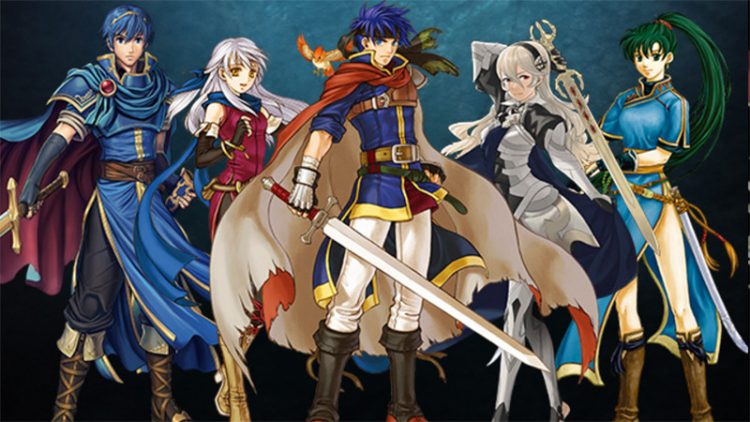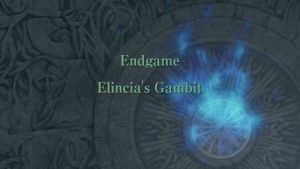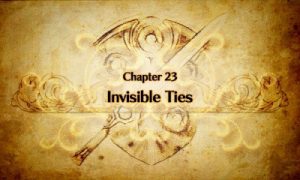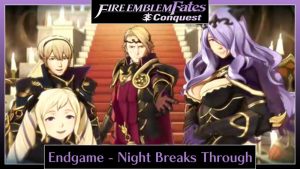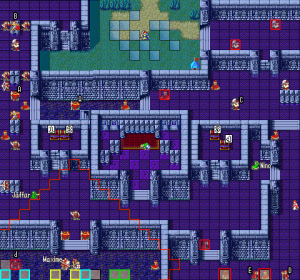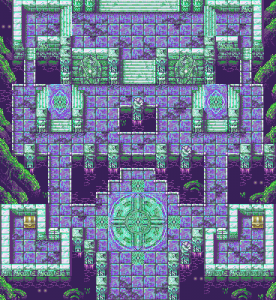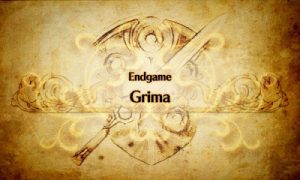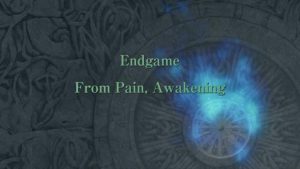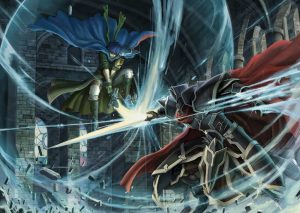In my life there are three things that matter: family, friends, and Fire Emblem. Like a million others, I was hooked on the series through Awakening. That game changed my life forever, and I soon went back and played every other North America released Fire Emblem game. As part of The Outerhaven’s Fire Emblem Month, I decided to undertake the daunting endeavor of ranking my Top 10 Fire Emblem chapters in history.
Two quicks note before we get into it. First, major spoilers for every Fire Emblem game are below. Turn around if you wish to avoid them! Second, I have not played the Japanese only releases. I hope to soon, but this list won’t include any chapters from Fire Emblem 1 through 6. Please let me know your favorites from those titles! I know they’re dramatically different from the newer games.
10. Chapter 17 – Day Breaks (Path of Radiance)
If you’ve listed to The Nintendo Entertainment Podcast, you’ll know that Path of Radiance has a special place in the hearts of The Outerhaven’s Nintendo Team. It’s the best entry in the series for my money. It’s epic story, well-written characters and great map design make it a real stand out.
Chapter 17, “Day Breaks”, is one of the best examples of its excellent storytelling. It’s a four part chapter that serves as a dramatic climax to the game’s second act. Ike leads the Greil Mercenaries into the destroyed Serenes Forest to prevent the heron Reyson from being captured by Duke Oliver’s men. With the blessing of the Apostle Sanaki, Ike finally has the chance to carry out justice for the Duke’s violation of the Laguz Emancipation Act.
The story implications that unfold through the four parts keep the chapter engaging. We see Reyson nearly give into to hatred and rage, unheard of from the naturally peaceful herons, attempting to kill all of the people in the forest with his song. Ike rescues Leanne, fighting through half the chapter with her on his back, and Apostle Sanaki shows just how far she’s willing to go to make things right with the heron clan. Not to mention the two epic scenes that close the chapter. The first has Reyson and Leanne singing the Galdrar of Rebirth, reviving the forest, while the second features Ike’s epic promotion from Ranger to Lord.
Each part of the stage map is well designed as well. There are different objectives for each part, keeping things varied. The destroyed forest has bogs that make balanced unit selection critical, multiple ways to go about clearing each objective, and allied reinforcements. That last point is something I’d really like to see become more frequent, as it levels the playing field and makes the chapter feel more dramatic.
9. Chapter 2 Endgame – Elincia’s Gambit (Radiant Dawn)
It stuns me every time I see Fire Emblem fans talking down about Elincia’s Gambit. For my money, it’s the second best chapter in Radiant Dawn, a game loaded with incredible levels that tie brilliantly into the narrative.
Elincia’s Gambit has us fighting for everything we built in Path of Radiance. Elincia’s rule is on the brink of collapse. Mutiny is quite literally at her doorstep and her most trusted knights are all away after falling into a trap. Lucia, her best friend and most trusted advisor, has been captured by the enemy. Still, Elincia fights on with a rag-tag band of allies.
That’s the real beauty of Elincia’s Gambit: You genuinely feel like you’re going to lose. The enemy nearly quadruples your number, and there’s no Ike to save you. Instead, you’re forced to rely on a farmhand in Brom, quirky village girl in Nephenee, and a lazy dracoknight in Haar. The task is daunting, and yet certainly achievable thanks to the terrain advantage. This battle constantly has you feeling like you could be overrun at any second, and even the arrival of the Crimean Royal Knights halfway through doesn’t alleviate the pressure much. They have a challenging road ahead in order to cut through the invading forces and arrive at Elincia’s side.
Defense missions are some of the best in Fire Emblem, especially because they give you the freedom to approach them however you’d like. In Elincia’s Gambit, it’s possible to break through the enemy lines and kill their leader, but doing so exponentially adds to the already steep challenge.
The icing on the cake? One of the most epic cutscenes in the series:
8. Chapter 23 – Invisible Ties (Awakening)
Fire Emblem fans who lump Awakening and Fates together when talking about the series’s narrative woes are making a huge mistake. Yes, Awakening‘s writing wasn’t flawless, but it was pretty damn good. Invisible Ties shows that perfectly. Players like myself’s first ever Fire Emblem chapter was “Invisible Ties: Premonition”. There, we saw our Avatar kill Chrom in a moment yet to come. We knew the day would arrive where we returned to that mysterious altar alongside Chrom, but could we change fate?
I’ll be honest with you… I cry every time I think about this chapter. It’s no exaggeration to say that Fire Emblem: Awakening changed my life forever. It made me believe that, as Chrom would say, “Anything Can Change!” The previous 22 chapters led Chrom and Robin on a worldwide journey. They dealt with the death of Chrom’s sister, two wars, and meeting with their own children from a destroyed future together. Without one, the other could not have succeeded. These two are as close as friends (or couples, if you married Chrom as female Robin) can be.
And yet, when push came to shove, Robin was unable to resist his Fell Dragon blood when Validar forced him to seize the Fire Emblem. Although players know going in that Chrom will survive the encounter this time around, the way the drama builds from the previous two chapters to this final moment is extremely effective. Seeing Robin once again strike Chrom as he did in the premonition made me audibly gasp. Lucina’s despair hangs in the air just long enough for you to really start to think “maybe this really happened…” only for a hero you thought was dead to shout “Don’t put too much stock in this destiny hogwash”. Basillo appears and reveals how Robin out thought Validar. Chrom rises to his feet and the rout is on.
The actual map itself isn’t anything special, although the fact that Chrom and Robin are separated from their other allies by Validar’s magic adds to the drama. It also allows you to wipe out the rest of the Grimleal before “killing” Validar before the plot twist reveals itself. Still, the emotional impact that this chapter had on me personally makes it one of my favorite levels in gaming, and I’m sure many players around the world feel the same way.
7. Endgame – Night Breaks Through (Conquest)
Conquest mastered the gameplay systems introduced in Fire Emblem: Awakening while adding old-school level design to its maps. The result is a brutally hard, yet rewarding, game that tests your strategic thinking in ways no other North American Fire Emblem game does. This game is hard, and it’s final chapter lives up to that reputation.
Takumi makes for one of the most surprising final bosses in Fire Emblem. On one hand, there was little doubt that he would reappear after throwing himself from the Great Wall of Suzanoh. Still, seeing him let an arrow fly just when you thought the war for Nohr’s heart was over had great shock value. His broken speech, ghastly appearance, and flowing power all create one of the most intimidating bosses around.
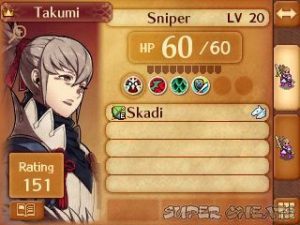
This chapter ties up the story well and capitalizes on its themes. Takumi, like Prince Lyon from Sacred Stones, is a villain you can truly feel for. He’s lost his oldest brother, been abandoned by his other brother, and has no idea if either of his sisters are even alive. His home has been conquered, his mother murdered before his eyes. Even his retainers died in the war, a war where his side was the noble one! Takumi lost everything, and only then was he able to be completely controlled and manipulated by Anankos. When staring the youngest Prince of Hoshido down for the final time on the battlefield, it’s impossible not to sympathize with him and wonder what how things would have been had you decided to fight alongside him. Seeing his body destroyed and controlled by a monster makes the player feel guilty for making the choice they made. Still, having your Nohrian siblings by your side reminds you why you decided to embrace the dark.
The map design is fairly basic, but it make for an epic and strategic battle. Shielding your allies with Dragon Veins to protect from Takumi’s blasts adds a challenging twist to a map filled with insanely strong enemies. You’ll fight ninjas with high evade rates, powerful mages on horseback, intimidating wyvern knights and endless waves of Faceless as you approach Takumi at the end of the hall. Without abusing staffs, it’s absolutely brutal to reach him unscathed. The first time I beat the chapter without losing a character Laslow hit a 3% crit to save himself… This map is challenging and to beat it without help from the RNG Gods you have to be a genuinely great Fire Emblem player.
But the best part about this level is its soundtrack. The epic music motivates you to press forward, and it remains my favorite endgame Fire Emblem track to this very day.
“Sing with me a song; Of Conquest and Fate”
6. Chapter 26 – The Battle Before Dawn (Fire Emblem 7)
Perhaps it’s due to the limitations of the Gameboy Advanced, but a lot of the handheld Fire Emblem maps don’t stand out in my mind like the Tellius or 3DS games do. Looking back at the chapter list, some of the best stages come from those games yet remain overlooked.
That’s certainly not true for The Battle Before Dawn. It’s one of the most chilling chapters imaginable, due to its plot implications and its difficulty. In fact, one could argue that no moment was more important in the Elibe saga than this fateful night in Bern.

Eliwood, Lyn and Hector arrive in the palace to protect Prince Zephiel from Black Fang assassins Nino and Jaffar. They are too late, however, but Nino overhears Zephiel praying to restore his family. She feels sympathy to him and refuses to do the job. Jaffar decides to disobey his orders and protect Nino while Ursula and Maxime try to hunt them down. Eliwood and company join the fray and ultimately succeed in saving Zephiel, Nino and Jaffar.
While those events may seem like just one step towards reaching the end of Eliwood’s journey, the chain reaction they have are profound. Zephiel learns that his father wants him dead, and his kind and gentle demeanor begin to change. Years later, the event would drive him to murder his father and claim the throne of Bern. He then would begin his plans to eliminate humanity and restore the world to dragon rule, a plot foiled by Eliwood’s son Roy in Binding Blade.
The significance of this chapter is in its philosophy. When playing through the stage, it’s impossible not to wonder what would have happened had Eliwood and company not shown up in time to save Zephiel. The events of Binding Blade never would have occurred. Hector wouldn’t have been doomed to die at the hands of Zephiel, and Roy could have lived out his life peacefully. Eliwood did the right thing by protecting this innocent child, and the long-term “reward” was losing his friend and seeing his son head off to war.
It really humanizes the world’s characters and makes everything feel real. The story logically flows perfectly and the player can understand and sympathize with all of the characters. Had Eliwood not shown up that night, the entire history of Elibe would have unfolded differently. One moment in time can dramatically change the world for millennia to come, and The Battle Before Dawn illustrates that in a relatable and effective way.
5. Endgame – Sacred Stone (Sacred Stones)
Sacred Stones is an underrated entry in the Fire Emblem series. It doesn’t dramatically build on the foundation of Fire Emblem 7, but its accomplishes a goal that video games and movies so often fail to achieve: nailing the villain.
Lyon has a special place in Fire Emblem fans’ hearts because, in a way, we are all him. Or at least we all COULD be him, if we give into our darker temptations and doubts. He is introduced as the best friend of the heroes, Eirika and Ephraim, and we’re told countless times that he’s a sure-fire ally for Renais within the Grado Empire. Flashbacks show Lyon as a gentle man who loves Eirika and admires Ephraim’s strength. He is wise, studious, and noble, despite his failing confidence. The game makes it seems as though Lyon will be an ally who joins our heroes in the late game, but nothing could be further from the truth.
Instead, when Ephraim encounters Lyon, he admits to being the reason the war started. He intends to resurrect the Demon King in order to harness his power to prevent a natural disaster from destroying Grado. Lyon, the gentle and innocent prince, is responsible for the deaths of thousands of innocents. It is he who upended the peace that ruled over the continent of Magvel, and he who killed Eirika and Ephraim’s father.
Still, we sympathize with him. Lyon’s reasons for starting the war were to save his kingdom from ruin, and his suppressed jealously and insecurity allowed his dark desires to manipulate him. Those desires, to be the strongest, to be the bravest, to win the girl… they exist in all of us. Lyon ultimately gave into those ambitions, and they twisted his heart and turned him into what he hated most of all.
The final chapter shows Ephraim and Lyon 1 1/2 years prior talking about their future. Lyon expresses that he fears that the future will change the friendship he shares with Ephraim, and Ephraim says even if Renais and Grado went to war, the two would still be friends. In the present, they both acknowledge that, despite all that has happened, they are still friends.
Still the highlight of the chapter is their pre-battle conversation. It’s gotta be the most badass moment in Fire Emblem, and it’s why Ephraim stands out as a special lord in my eyes.
“No, you’re still no match for me Lyon. You should never have gone down this path… Here I come Lyon.”
4. Endgame: Grima (Awakening)
This is another one that has my throat well up every time I think about it. It’s an incredibly epic chapter, second only to a later entry in this list, but it’s emotional power stems from the impact it had on us first-time players. This was the first time we heard all of our favorite characters deliver brief speeches before taking on the final boss. The first time we wielded a divine weapon against a dragon. The first time we knew our journey with a Fire Emblem game was at its end. And man, was that special.
On the back of the Fell Dragon, Grima, Chrom’s army prepares to end the war once and for all. The scene is perfectly set. Grima nearly kills the Shepherds and seals Robin within itself. Just when all hope seems lost and Robin is ready to give up, he hears the voices of the people he loves. “Fight back!” Chrom yells, as Robin rises to his feet. It’s the bonds you’ve built with the cast of characters throughout the journey pull you through. The times Lissa dropped frogs down your shirt, those moments when Lucina made you cry. The time you tried teaching Frederick to eat bear meat, and those awkward encounters with Tharja. All of those memories and more propel Robin back to the battlefield, alongside his friends and allies. It’s beautiful and tugs on your heart.
On top of the emotional impact of the chapter, the battle itself is actually very well designed. There’s a lot of room for different strategies, and the battle is certainly not a cake walk. Grima himself is challenging as well, and the game forces you to make one final choice that shows just how far our heroes are willing to go for one another. Chrom is willing to put Grima back to sleep without destroying him to save his best friend, while Robin wants to give up his own life to secure the future for his friends and the generations that follow. Fire Emblem: Awakening is all about bonds, and this chapter makes you feel the power of those bonds throughout.
Of course, it doesn’t hurt that Id: Purpose is playing in the background.
https://www.youtube.com/watch?v=Bio99hoZVYI
3. Chapter 25 – Ryoma (Conquest)
Fire Emblem games are at their best when they make you feel things. The whole series hinges on that. If we didn’t care about the characters who fought for us, permadeath would mean nothing. If we didn’t have a vested interest in seeing the hero through their journey, the stories would fall flat. For all Conquest’s story flaws, Chapter 25, Ryoma, grabs you by the heart and rips it from your chest.
“I killed Hinoka,” Corrin tells Ryoma. It’s a lie, but with King Garon watching Corrin has to act like he truly killed Ryoma’s (and his own) sister. The prince of Hoshido, defending the throne room as the last line of defense, finally snaps and lunges at Corrin. Throughout the entire Conquest storyline, we’re constantly seeing that Ryoma really just wants his brother to come home. At times it almost seems like he understands why Corrin sided with Nohr. Still, hearing those words and seeing the bloody lance send him off the deep end. Ryoma and Corrin duel in a sealed off room while the rest of the Nohrian army fights the Hoshidans. Thorn in You plays in the background, the same song that played when you first decided to side with Nohr. This moment is a direct result of your choice… there’s no running away from that fact.
https://www.youtube.com/watch?v=AVwMGElwAWE&t
Much like the endgame chapter, Chapter 25 is incredibly difficult. Even on the lower difficulty settings, this chapter tests your strategic abilities. There are two levers that need to be pressed, one guarded by each of Ryoma’s retainers. The ninjas and mechanical dolls that fill the rooms leading to them all can debuff your army and wipe Nohr’s army out without trouble. Navigating these halls requires careful planning, excellent resource management throughout the game, and patience. This was one of the chapters that made me wish I didn’t waste my rescue staff a few chapters earlier, or that I reclassed certain characters differently. Conquest is all about testing your ability to plan long term, and failing to do so will make this level nearly impossible. Still, it’s doable. And once you’ve done it and defeated Ryoma the saddest moment in Fates unfolds.
“Thank you Corrin. I finally understand. It’s alright. Everything will be alright… my beloved brother”.
https://www.youtube.com/watch?v=j74DKi7N1uU
2. Chapter 3 Endgame – From Pain, Awakening (Radiant Dawn)
While Radiant Dawn is rightly criticized for it’s failure to make new connections between its characters, its story takes on a huge scope and somehow pulls it off nearly perfectly. This results in some epic set piece battles between the game’s armies, especially when the two groups facing one another are both controlled by the player at different points in the game. Chapter 3-E has the player controlling the Laguz Alliance, led by Ike, against Micaiah’s Dawn Brigade. Combatants from all of Tellius’s nations line the battlefield, even from the neutral nation of Goldoa, and Lehran’s Medallion glows bright.
A number 0 appears on the screen when the battle starts and increases for every unit that’s killed. The chapter is interrupted by story scenes as the count ticks higher, and the player’s heart begins to race as the world throws itself closer to certain doom. The interruptions do such a great job of showcasing how the world’s characters are dealing with the ceaseless fighting and hammer home the point that both the Apostle’s Army and Daein’s Army believe they’re doing the right thing. The entire story comes together when Mist faints when the casualties hit 8o.
Just thinking of the story elements that come together here send shivers down my spine. The revelation that Micaiah’s bird is the voice of the Dark God, the truth behind the “evil” nature of said God, Micaiah and Sanaki’s relationship, and, of course, the dramatic judgement of Ashera scene. As that casualty count ticks higher, we get closer and closer to knowing the truth behind the many mysteries found in the Tellius Saga.
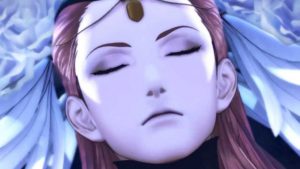
The battle itself is epic as well. Seeing the armies of all the nations gathered on one gigantic battlefield holds significant emotional weight. The beast and bird laguz charge against Daein alongside Ike, while Micaiah’s forces try desperately to hold them off despite their inferior numbers. It’s a battle Daein cannot win, yet they fight relentless to do the impossible.
Perhaps the most impressive achievement of all is the way Chapter 3-E makes the player literally feel the narrative. We’ve played as both the Dawn Brigade and the Greil Mercenaries, but playing this chapter shows just how much stronger Ike’s team is. Players sense a certain inevitability about the battle. We know that the Laguz Alliance will win, and by the time the ominous timer strikes 80 they’ve pretty much done so.
Narratively, Radiant Dawn never cuts any corners or uses “video game logic” to pull the main characters through. Seeing these two armies clash, knowing that Ike will win, makes you feel accomplished for succeeding during Micaiah’s 3-13 chapter before it. The conflict always feels so authentic in Radiant Dawn, and that all comes together in Chapter 3-E. Barring the apocalypse, there’s nothing Micaiah can do to stop Ike’s forces from breaking through.
Then, this happens:
1. Chapter 27 – Moment of Fate (Path of Radiance)
This is the climax of the entire Fire Emblem series thus far, in my opinion, and only Earthbound‘s final boss can rival it as my favorite moment in gaming. Ike versus The Black Knight… it doesn’t get any better than this.
Since the moment Greil was killed, Ike’s journey was destined to arrive at this point. The chaos of taking up Greil’s role as the head of the mercenaries, the drama in Begnion, the battle in Daein’s capital… that all suddenly becomes a sideshow. This is Ike’s chance to avenge his father. It’s what he’s desired most throughout the game, and the test of strength finally arrives in Nados Castle. When Ike takes up Ragnell against the Black Knight, it’s impossible not to get caught up in the moment.
One of the things I love about this chapter is the fact that it’s completely unscripted. Ike could very well lose to the Black Knight. His stats are still superior to Ike’s, and his Luna skill results in devastating damage. Ike needs to be well trained to win, and even then the battle could be dependent upon whether Ike triggers a skill or not. The six turn limit forces you to beat the Black Knight quickly, or not at all. Knowing that it’s possible to clear the game without Ike extracting revenge adds pressure as the turn count ticks higher.
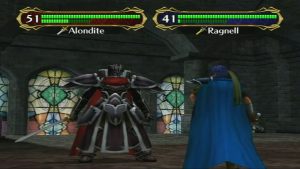
Ike himself makes this drama possible. He’s such a lovable and relatable character, especially in that moment. You feel what Ike must be feeling: nervous, excited, resolved and maybe even scared. Mist joining the fray adds to the scene, as she suffered just as much as Ike had from Greil’s death. It truly feels like the ghost of Greil is challenging the Black Knight as his children fight to avenge him. Striking him down with Aether makes you want to scream with joy.
Once you’ve defeated him, it feels like the weight of the world has been lifted from your shoulders. The rest of the game almost feels like a formality, and it speaks to Ike’s character that he doesn’t let that victory distract him from the goal of killing Ashnard. The feeling of accomplishment, knowing that Ike has done the inconceivable and avenged his lost father, is a feeling that you won’t find too often.
“Ike has avenged his father by defeating the Black Knight in single combat. That night, he sleeps until well past dawn. It is the first time since Greil’s death that he has done so.”
Honorable Mentions
Fire Emblem has some incredibly powerful moments throughout its nearly 30 year lifespan. Because I haven’t played all the Japanese only games, I had to leave off the tragic Battle of Belhalla, which really deserves an honorable mention. There are a few other favorites I had to cut as well, including Cog of Destiny (FE7), Dragon’s Gate (FE7), Blood Runs Red (PoR), Defending Talrega (PoR), Renewal (Awakening), Light Scatters (Birthright), Xander (Birthright), and Dawn Breaks (Birthright).
What are your favorite Fire Emblem chapters? Think it over and let me know! In the meantime, check out Triforce Todd’s first Fire Emblem month piece: Why Fire Emblem Matters. Thanks for reading!


